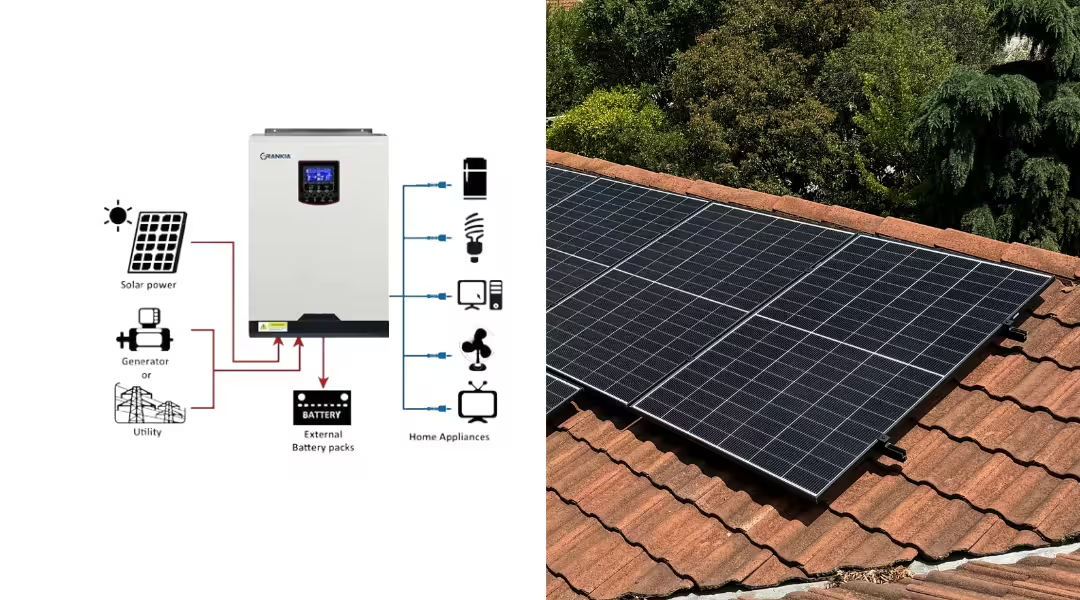Australia has one of the highest rates of rooftop solar in the world, and more households are now adding batteries to store their clean energy. But before you can start producing, storing, and exporting electricity, you need to understand how the grid connection process works—and how it differs from going off-grid entirely.
This guide covers the latest rules as of 2025, including the new federal battery rebate, off-grid vs grid-connected systems, and the steps to connect solar, batteries, and embedded generation safely and legally.
Off-Grid vs Grid-Connected Solar Systems
What is an Off-Grid System?
An off-grid system (also called a stand-alone power system) operates independently from the electricity network. It relies entirely on solar panels, large batteries, and often a backup generator.
Advantages:
- Complete energy independence
- No electricity bills
- A solution for remote properties
Challenges:
- Higher upfront cost due to larger battery and backup needs
- More complex maintenance
- Requires careful energy management
What is a Grid-Connected System?
A grid-connected solar system remains linked to the local electricity network. Solar powers your home first, excess energy is exported to the grid (often with a feed-in tariff), and you can draw power when the sun isn’t shining. Adding a battery allows you to store energy and use it later.
Advantages:
- Lower upfront cost compared to off-grid
- Reliable supply thanks to grid backup
- Eligible for rebates and feed-in tariffs
How to Connect a Solar or Battery System to the Grid
The connection process varies by state and electricity distributor, but the general steps are similar across Australia.
Step 1: Application to Your Network
Your installer submits a connection application to your Distribution Network Service Provider (DNSP). This includes system size, inverter details, and whether a battery is included.
Step 2: Technical Assessment
The DNSP checks your area’s network capacity, voltage stability, and safety impacts. Larger systems may require more detailed engineering studies.
Step 3: Approval and Conditions
If approved, you’ll receive a connection offer outlining:
- Any export limits (sometimes zero-export)
- Inverter settings
- Metering upgrade requirements
Step 4: Installation & Compliance
Your accredited installer completes the installation and issues a Certificate of Electrical Safety/Compliance, which is critical for both legal activation and rebate eligibility.
Step 5: Metering and Commissioning
A smart meter is installed or reconfigured, and the DNSP authorises the system to export to the grid. Only once this step is complete can your system legally begin operation.
Rules and Standards You Need to Know
Inverter and Equipment Standards
All new systems must meet AS/NZS 4777.2 standards. This ensures inverters can ride through grid disturbances and provide safe disconnection when needed.
Export Limits and Dynamic Control
DNSPs may impose export limits due to local grid constraints. Increasingly, networks are adopting dynamic export limits, allowing households to export more when the grid has capacity, rather than a fixed zero-export rule.
Batteries and the Cheaper Home Batteries Program
From 1 July 2025, the federal Cheaper Home Batteries Program (CHBP) provides rebates through Small-scale Technology Certificates (STCs). Key rules include:
- Battery capacity must be between 5 kWh and 50 kWh
- Battery must be paired with rooftop solar
- Only one battery per premises is eligible
- Installation date (compliance certificate) must be on or after 1 July 2025
NSW and State Incentives
While the previous NSW battery rebate ended in June 2025, households may now receive additional incentives for connecting their batteries to Virtual Power Plants (VPPs). These payments can stack with the federal rebate.
Embedded Generation and Larger Systems
For businesses or farms installing larger generators (above DNSP thresholds), the process moves into registered embedded generation under the National Electricity Rules. This may involve:
- Negotiations with DNSPs and AEMO
- More detailed protection settings
- Possible network upgrade contributions
Planning early and using an experienced installer is essential for larger projects.
Checklist Before You Install
✅ Use a Clean Energy Council–accredited installer
✅ Confirm your equipment is on the approved product list
✅ Ask your installer to manage the DNSP application
✅ Check if your system will face export limits or if dynamic exports are available
✅ If joining a VPP, understand payment terms and connectivity requirements
Grid connection rules may feel complex, but they are designed to keep Australia’s power system reliable and safe while allowing more renewable energy to flow. For most households, a grid-connected system with battery storage is the most cost-effective and flexible option, while off-grid systems suit only specific remote properties.
By staying up to date with the latest federal and state programs, you can maximise rebates, reduce upfront costs, and future-proof your energy system.



